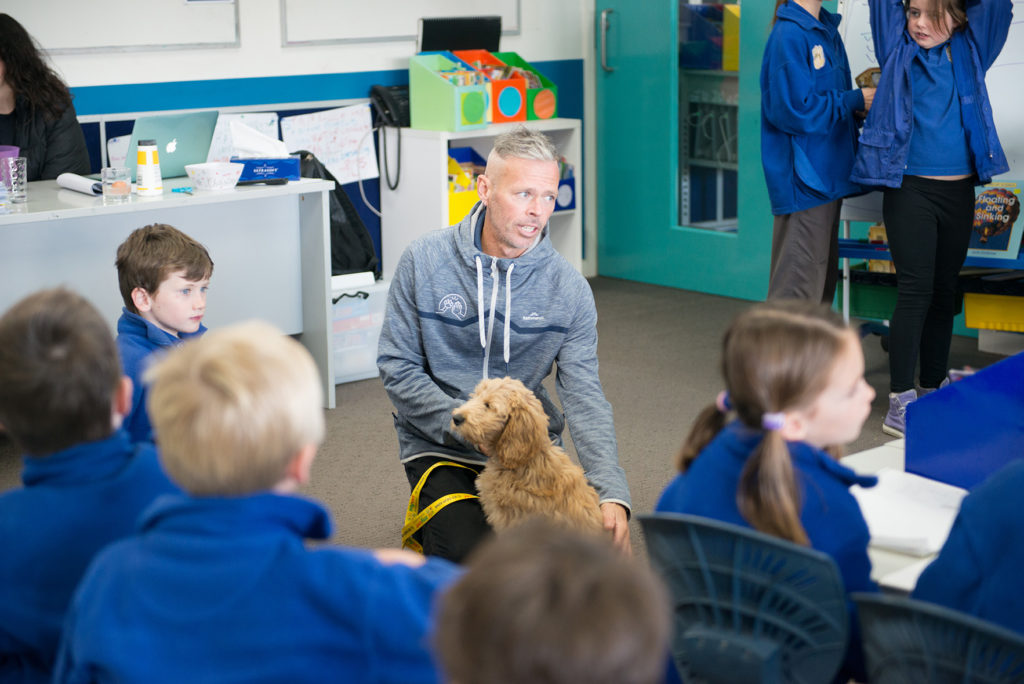Seeing a furry, friendly face at the school gate each morning can be the difference between school refusal and sadness, and a relaxed – and even happy – walk into the school grounds.
At Caulfield Junior College in Melbourne, it’s a difference that prep teacher, Georgia Leonard-Shannon has seen Luna the groodle (a golden retriever/poodle-cross) help achieve regularly.
According to Dogs Connect, the company that provided the preliminary support and accredited training the teachers, school staff and members of the school community experienced as part of their commitment to having Luna the wellbeing dog at the school, the benefits of wellbeing dogs in schools can be enormous.
Simply being near a dog when stressed can reduce anxiety and, with one Dogs Connect survey of their school clients revealing that 92 percent of students said they felt more relaxed during teaching and learning time when there was a dog in the classroom, it’s a presence that helps both students and teachers enjoy a calmer, safer, and more effective learning environment.
Read more: Wellbeing dogs help create connections that matter
For Dogs Connect founder and former teacher Grant Shannon, the success of the wellbeing dog program is about ensuring each dog is treated with care and respect. He doesn’t use the words ‘therapy dog’ and says he aims to deliver an approach that “revolutionises the way we view canine companionship in educational settings”.
As Mr Shannon’s niece, Ms Leonard-Shannon had some personal insights into his unique approach, even before she completed her own teaching degree.
Then, as a student teacher on placement in her home town of Bendigo, in regional Victoria, she was able to see wellbeing dogs in action at primary schools she worked within.
Wellbeing dogs create calm connections in school communities
When she settled into her first full-time teaching role after a move to Melbourne, Ms Leonard-Shannon proposed the idea that she could get a dog for the purpose of training it as a wellbeing dog for the school.
“Luckily, all the leadership here were really open to it,” she says.
Today, the groodle she chose for its size (small dogs are not recommended in busy school settings), its non-shedding fur and its intelligence, is a valued member of the school community, complete with her own official staff headshot.

“Wellbeing was already a big focus at the school prior to the impact of COVID-19,” says Ms Leonard-Shannon. “Post-COVID, it became even more important. The perception is, of course, that Luna is part of a wellbeing program for students but it’s really great to see the little ways that her presence also impacts the staff.”
When they walk into the staffroom, says Ms Leonard-Shannon, “they’re all really happy to see her”.
“Even having her at our meetings makes a positive change,” she says. “Schools can be quite busy, hectic spaces but she really calms the vibe in our spaces and staff are happy to take her out for a run during their break, or take her for a walk.”
Most of the staff in the school now have completed a level of training as part of the wellbeing dog program, “so they know the correct way to walk her on the lead and how to interact with her”, says Ms Leonard-Shannon.
Consistent care and boundaries are key to success
And it’s this commitment to consistency of care that helps ensure wellbeing dogs can play the important role they do, but still live their own best life – simply enjoying being a dog.
There is a roster for Luna, and during the four days she attends the school, a timetable of classes and duties sees her shift from the meet-and-greet at the school gate to help soothe anxious arrivals, to the quiet (and often snuggly) time spent in the library for story-time. In between, she migrates from classroom to classroom within the grand old school building, simply to be a presence during various lessons, across different year levels. More focused connections are made between Luna and the students during dedicated wellbeing sessions.
“Teachers can’t be in charge of her as her carer unless they have had the thorough training but there is already a big group of about 10-12 people who have that training – and it will eventually roll-out to all the teaching staff,” says Ms Leonard-Shannon.

Luna was almost six months old before she spent her first day at school and was already, says Ms Leonard-Shannon, impeccably trained in the basics of good manners.
Making sure boundaries and expectations are consistent is critical and, although Luna goes home with Ms Leonard-Shannon as a much-loved family pet, the house rules – including not being allowed on the couch – help reinforce the polite, safe presence Luna needs to showcase within school hours.
In any diverse school community, though, no matter how well trained a dog may be, there will always be some members of that community who have their own unique hesitations about having a dog too close.
“Before I even got Luna as a puppy, there was a big roll-out with the school, which involved sending letters home to families to share the plans of bringing a wellbeing dog into the daily school environment,” says Ms Leonard-Shannon.
For some families, with no experience as dog owners, and fear of dogs, assuring those families of the positive benefits of the program was critical.
For Luna’s wellbeing, ensuring the entire school community – from eager preps to senior staff – understood the dog’s need for downtime and respect was just as important.

“It’s a high stimulus environment for her and she needs breaks,” says Ms Leonard-Shannon.
On the recommendation of the Dogs Connect program, Luna has her own private fenced space on school grounds to have off-leash alone time. The discovery that Luna found the fast-paced noisy nature of yard duty overwhelming means she can now spend quieter time resting before re-joining the classrooms that, Ms Leonard-Shannon says “she loves”.
“I’m sure if she had her choice, Luna would be here five days a week,” she says. “But it’s recommended that four days is enough, so she stays home by herself on Wednesdays.”
Although the majority of Caulfield Junior College’s 500+ students are enrolled in the school’s French Binational Program, Ms Leonard-Shannon says she doesn’t know whether any of the immersive approach to language learning has rubbed off on Luna yet. It did have some influence on choosing the name, though, Ms Leonard-Shannon says.
“In French, ‘lune’ is moon,” she says. “We did think about getting the school kids involved in choosing the name but I saw some of the early name suggestions and decided to name her myself – I am the one who has to call her out loud at the dog park!”
To help cater to Luna’s health and happiness, part of the training approach is recognising the responsibilities of being in the school setting, and making it clear that there is a different level of freedom and independence in the home setting. Luna wears a specific collar and leash for school-time, and another one for home-time – and, says Ms Leonard-Shannon, she knows the difference.
“She goes to the dog park, rolls in mud and is a regular dog at home, but on Mondays, Tuesdays, Thursdays and Fridays, as soon as I grab my car keys, she’s so excited to come in the car.”
And the children are excited too.
“I had a student in my class last year who had some issues separating from her parents,” says Ms Leonard-Shannon. “Luna would be at the school gate to greet her and that child could take Luna’s lead and walk in with her and it made such a difference. It’s little wins like that are worth celebrating.”








